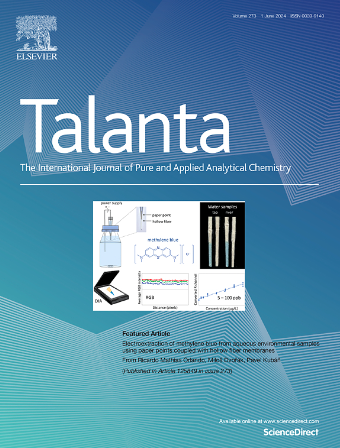Fluorescence-activated cell sorting-based efficient screening of monensin monoclonal antibodies and applications in lateral flow immunoassay
IF 5.6
1区 化学
Q1 CHEMISTRY, ANALYTICAL
引用次数: 0
Abstract
Monensin is widely used in livestock and poultry for disease prevention and growth promotion. Still, its improper use can lead to residues in animal-derived foods, posing risks to human health. In immunoassays, monoclonal antibodies (mAbs) remain a preferred choice due to their high sensitivity and specificity. However, traditional hybridoma technology often suffers from a lengthy screening cycle and the risk of losing effective clones. To address these limitations, this study employed fluorescently labeled monensin antigens combined with fluorescence-activated cell sorting (FACS) for rapid screening of hybridoma cells secreting anti-monensin mAbs. Compared to the conventional limiting dilution method, this approach increased the yield of specific hybridoma cells by tenfold and reduced the screening cycle from four weeks to one week. Based on the selected mAb (4E6), a rapid visual lateral flow immunoassay (LFIA) was developed for on-site detection of monensin, with a total detection time of 10 min. The assay exhibited a half-maximal inhibitory concentration (IC50) of 2.32 μg/kg and a linear detection range of 0.32–10.3 μg/kg. This study provides a promising strategy for efficient hybridoma cell screening and practical monitoring of monensin residues in environmental and food samples.

莫能菌素被广泛用于家畜和家禽的疾病预防和生长促进。然而,使用不当会导致动物源性食品中出现残留,从而对人类健康造成危害。在免疫测定中,单克隆抗体(mAbs)因其高灵敏度和特异性仍是首选。然而,传统的杂交瘤技术往往存在筛选周期长和有效克隆丢失的风险。为了解决这些局限性,本研究采用了荧光标记的莫能菌素抗原,并结合荧光激活细胞分拣技术(FACS)来快速筛选分泌抗莫能菌素 mAbs 的杂交瘤细胞。与传统的极限稀释法相比,这种方法将特异性杂交瘤细胞的产量提高了十倍,并将筛选周期从四周缩短到一周。根据筛选出的 mAb(4E6),开发了一种用于现场检测莫能菌素的快速可视横向流动免疫分析法(LFIA),总检测时间为 10 分钟。该测定的半最大抑制浓度(IC50)为 2.32 μg/kg,线性检测范围为 0.32-10.3 μg/kg。这项研究为高效筛选杂交瘤细胞和实际监测环境和食品样品中的莫能菌素残留提供了一种可行的策略。
本文章由计算机程序翻译,如有差异,请以英文原文为准。
求助全文
约1分钟内获得全文
求助全文
来源期刊

Talanta
化学-分析化学
CiteScore
12.30
自引率
4.90%
发文量
861
审稿时长
29 days
期刊介绍:
Talanta provides a forum for the publication of original research papers, short communications, and critical reviews in all branches of pure and applied analytical chemistry. Papers are evaluated based on established guidelines, including the fundamental nature of the study, scientific novelty, substantial improvement or advantage over existing technology or methods, and demonstrated analytical applicability. Original research papers on fundamental studies, and on novel sensor and instrumentation developments, are encouraged. Novel or improved applications in areas such as clinical and biological chemistry, environmental analysis, geochemistry, materials science and engineering, and analytical platforms for omics development are welcome.
Analytical performance of methods should be determined, including interference and matrix effects, and methods should be validated by comparison with a standard method, or analysis of a certified reference material. Simple spiking recoveries may not be sufficient. The developed method should especially comprise information on selectivity, sensitivity, detection limits, accuracy, and reliability. However, applying official validation or robustness studies to a routine method or technique does not necessarily constitute novelty. Proper statistical treatment of the data should be provided. Relevant literature should be cited, including related publications by the authors, and authors should discuss how their proposed methodology compares with previously reported methods.
 求助内容:
求助内容: 应助结果提醒方式:
应助结果提醒方式:


